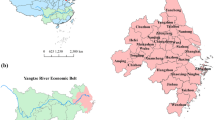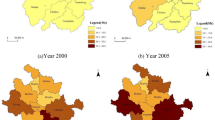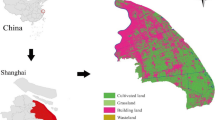Abstract
The Chengdu-Chongqing twin-city economic circle is a vital growth pole and a new power source for Chinese high-quality development. Studying the spatial-temporal characteristics of carbon emissions and the role of factors affecting them under the transportation perspective is of great significance for this region to realize the carbon peak and carbon neutrality and to formulate carbon emission reduction policies. We use the exploring spatial data analysis (ESDA) and spatial regression model combined with the STIRPAT model, and research finding: (1) The total carbon emissions in the research area gradually increased from 2014 to 2020, but the growth rate showed a significant decline in 2019. (2) There is significant spatial heterogeneity of carbon emissions in the study area; the hotspot areas of total carbon emissions are in Chongqing and Chengdu, forming a high-low aggregation of carbon emissions. Per capita carbon emissions show a high trend in the southwest and a low in the northeast. (3) From the factors of transportation perspective, highway density and private vehicles have a positive impact on carbon emissions, and urban road areas and public transportation have a very significant inhibition of carbon emissions and a spatial spillover effect. (4) Other factors, such as population size, national economic development, urbanization level, and industrial structure, all have a positive effect on carbon emissions, and disposable income has a negative effect on carbon emissions.








Similar content being viewed by others
Data Availability
The datasets involved in our study were derived from the following public domain resourses: 1) EPSDATA (https://www.epsnet.com.cn/index.html#/index). 2) https://tjj.sc.gov.cn/scstjj/c105855/nj.shtml. 3) https://tjj.cq.gov.cn/zwgk_233/tjnj/. 4) https://scjtnj.org.cn/run/website/trun.html?path=yuanshu. 5) http://tjj.my.gov.cn/tjnj/index.html. 6) https://stjj.leshan.gov.cn/stjj/tjnj/list.shtml.
References
Anselin L (1995) Local indicators of spatial association-lisa. Geogr Anal 27:93–115. https://doi.org/10.1111/j.1538-4632.1995.tb00338.x
Brand C, Goodman A, Ogilvie D (2014) Evaluating the impacts of new walking and cycling infrastructure on carbon dioxide emissions from motorized travel: a controlled longitudinal study. Appl Energy 128:284–295. https://doi.org/10.1016/j.apenergy.2014.04.072
Cao J, Wang S, Fan X, Yang X, Zheng H (2023) Correlation analysis of regional carbon emission intensity and green industry development-a case study of Chengdu-Chongqing region. Heliyon 9:e21683. https://doi.org/10.1016/j.heliyon.2023.e21683
Chai Z, Yan Y, Zibibula S, Yang S, Maliyamuguli A, Wang Y (2022) Carbon emissions index decomposition and carbon emissions prediction in Xinjiang from the perspective of population-related factors, based on the combination of STIRPAT model and neural network. Environ Sci Pollut Res Int 29:31781–31796. https://doi.org/10.1007/s11356-021-17976-4
Chang J, Sun P, Wei G (2022) Spatial driven effects of multi-dimensional urbanization on carbon emissions: a case study in Chengdu-Chongqing urban agglomeration. Land (Basel) 11:1858. https://doi.org/10.3390/land11101858
Chen X, Qin J, Yao J, Yang Z, Li X (2023) The distribution and impact characteristics of small-scale carbon emissions in the Chengdu–Chongqing region. Atmosphere (Basel) 14:216. https://doi.org/10.3390/atmos14020216
Dai X, He Y, Zhong Q (2015) Analysis of CO2 emission driving factors in China’s agriculture based on expanded Kaya identity. J Univ Chin Acad Sci 32:751–759
Dong F, Zhu J, Li Y et al (2022) How green technology innovation affects carbon emission efficiency: evidence from developed countries proposing carbon neutrality targets. Environ Sci Pollut Res Int 29:35780–35799. https://doi.org/10.1007/s11356-022-18581-9
Ehrlich PR, Holdren JP (1971) Impact of population growth. Science 171:1212–1217. https://doi.org/10.1126/science.171.3977.1212
Elhorst JP (2014) Matlab software for spatial panels. Int Reg Sci Rev 37:389–405. https://doi.org/10.1177/0160017612452429
Guo F, Zhang L, Wang Z, Ji S (2022) Research on determining the critical influencing factors of carbon emission integrating gra with an improved stirpat model: taking the Yangtze River Delta as an example. Int J Environ Res Public Health 19:8791. https://doi.org/10.3390/ijerph19148791
Hodson EL, Brown M, Cohen S et al (2018) U.S. Energy sector impacts of technology innovation, fuel price, and electric sector CO2 policy: results from the EMF 32 model intercomparison study. Energy Econ 73:352–370. https://doi.org/10.1016/j.eneco.2018.03.027
Jiang X, Ma J, Zhu H, Guo X, Huang Z (2020) Evaluating the carbon emissions efficiency of the logistics industry based on a super-sbm model and the malmquist index from a strong transportation strategy perspective in China. Int J Environ Res Public Health 17:8459. https://doi.org/10.3390/ijerph17228459
Jiang Y, Zhong S, Wang Y, Huang X (2022) Spatio-temporal characteristics and influencing factors of carbon emission peak by province of China. J Nat Resour 37:1289–1302. https://doi.org/10.31497/zrzyxb.20220513
Jiang Y, Zhou Z, Liu C (2019) The impact of public transportation on carbon emissions: a panel quantile analysis based on Chinese provincial data. Environ Sci Pollut Res Int 26:4000–4012. https://doi.org/10.1007/s11356-018-3921-y
Khurshid A, Deng X (2021) Innovation for carbon mitigation: a hoax or road toward green growth? Evidence from newly industrialized economies. Environ Sci Pollut Res Int 28:6392–6404. https://doi.org/10.1007/s11356-020-10723-1
Khurshid A, Khan K, Chen Y, Cifuentes-Faura J (2023a) Do green transport and mitigation technologies drive OECD countries to sustainable path? Transp Res Part D: Transp Environ 118:103669. https://doi.org/10.1016/j.trd.2023.103669
Khurshid A, Khan K, Cifuentes-Faura J (2023b) 2030 agenda of sustainable transport: can current progress lead towards carbon neutrality? Transp Res Part D: Transp Environ 122:103869. https://doi.org/10.1016/j.trd.2023.103869
Khurshid A, Khan K, Saleem SF, Cifuentes-Faura J, Cantemir Calin A (2023c) Driving towards a sustainable future: transport sector innovation, climate change and social welfare. J Clean Prod 427:139250. https://doi.org/10.1016/j.jclepro.2023.139250
Khurshid A, Rauf A, Qayyum S, Calin AC, Duan W (2023d) Green innovation and carbon emissions: the role of carbon pricing and environmental policies in attaining sustainable development targets of carbon mitigation—evidence from central-eastern Europe. Environ Dev Sustain 25:8777–8798. https://doi.org/10.1007/s10668-022-02422-3
Lei H, Zeng S, Namaiti A, Zeng J (2023) The impacts of road traffic on urban carbon emissions and the corresponding planning strategies. Land (Basel) 12:800. https://doi.org/10.3390/land12040800
Li H, Lin T (2022) Do land use structure changes impact regional carbon emissions? A spatial econometric study in Sichuan Basin, China. Int J Environ Res Public Health 19:13329. https://doi.org/10.3390/ijerph192013329
Li P, Zhao P, Brand C (2018) Future energy use and CO2 emissions of urban passenger transport in China: a travel behavior and urban form based approach. Appl Energy 211:820–842. https://doi.org/10.1016/j.apenergy.2017.11.022
Li Q, Chen J, He J (2021a) Analysis of carbon emission characteristics and spatial difference based on inventory accounting method: a case study of Sichuan province. Environ Pollut Control 43:1513–1519. https://doi.org/10.15985/j.cnki.1001-3865.2021.12.005
Li Y, Dong H, Lu S (2021b) Research on application of a hybrid heuristic algorithm in transportation carbon emission. Environ Sci Pollut Res Int 28:48610–48627. https://doi.org/10.1007/s11356-021-14079-y
Li Z, Hu M, Zhang A, Zhou N (2021c) Influence and spillover effect of industrial eco-efficiency on PM_(2.5) pollution. J Nat Resour 36:737–751. https://doi.org/10.31497/zrzyxb.20210315
Li Y, Li T, Lu S (2021d) Forecast of urban traffic carbon emission and analysis of influencing factors. Energy Effic 14:84. https://doi.org/10.1007/s12053-021-10001-0
Li C, Li H, Qin X (2022a) Spatial heterogeneity of carbon emissions and its influencing factors in China: evidence from 286 prefecture-level cities. Int J Environ Res Public Health 19:1226. https://doi.org/10.3390/ijerph19031226
Li Z, Zhou Y, Zhang C (2022b) The impact of population factors and low-carbon innovation on carbon dioxide emissions: a Chinese city perspective. Environ Sci Pollut Res Int 29:72853–72870. https://doi.org/10.1007/s11356-022-20671-7
Li Y, Khurshid A, Khan K (2023a) Optimization of coal-to-liquid processes; a way forward towards carbon neutrality, high economic returns and effective resource utilization. Evidences from China. Fuel (Lond) 344:128082. https://doi.org/10.1016/j.fuel.2023.128082
Li Z, Liu A, Shang W, Li J, Lu H, Zhang H (2023b) Sustainability assessment of regional transportation: an innovative fuzzy group decision-making model. IEEE Trans Intell Transp Syst 24:15959–15973. https://doi.org/10.1109/TITS.2023.3275141
Lian L, Lin J, Yao R, Tian W (2020) The co2 emission changes in China’s transportation sector during 1992–2015: a structural decomposition analysis. Environ Sci Pollut Res Int 27:9085–9098. https://doi.org/10.1007/s11356-019-07094-7
Liao X, Yang X, Niu Z (2023) Spatio-temporal changes and effects on terrestrial carbon emission in Chengdu-Chongqing urban agglomeration. Environ Sci Technol 46:211–225. https://doi.org/10.19672/j.cnki.1003-6504.1614.22.338
Liu F (2023) The impact of China’s low-carbon city pilot policy on carbon emissions: based on the multi-period DID model. Environ Sci Pollut Res Int 30:81745–81759. https://doi.org/10.1007/s11356-022-20188-z
Liu X, Gao C, Zhang Y et al (2018) Spatial dependence pattern of carbon emission intensity in China’s provinces and spatial heterogeneity of its influencing factors. Sci Geogr Sin 38:681–690
Liu H, Fan J, Zeng Y, Guo R (2019) Spatio-temporal differences in carbon intensity in high-energy-intensive industry and its influence factors in China. Acta Ecol Sin 39:8357–8369
Liu T, Dong H, Gao L, Luo T (2022a) Factors influencing decoupling of industrial carbon emissions and countermeasures to reduce emissions in Ningxia. J Ningxia Univ (Nat Sci Ed) 43:1–6
Liu Q, Li H, Shang W, Wang K (2022b) Spatio-temporal distribution of Chinese cities’ air quality and the impact of high-speed rail. Renew Sust Energ Rev 170:112970. https://doi.org/10.1016/j.rser.2022.112970
Liu J, Meng W, Huang B, Li Y (2022c) Factors influencing intergovernmental cooperation on emission reduction in Chengdu-Chongqing urban agglomeration: an evolutionary game theory perspective. Int J Environ Res Public Health 19:14848. https://doi.org/10.3390/ijerph192214848
Liu W, Zuo B, Qu C, Ge L, Shen Q (2022d) A reasonable distribution of natural landscape: utilizing green space and water bodies to reduce residential building carbon emissions. Energy Build 267:112150. https://doi.org/10.1016/j.enbuild.2022.112150
Lv T, Hu H, Zhang X, Xie H, Wang L, Fu S (2022) Spatial spillover effects of urbanization on carbon emissions in the Yangtze River Delta urban agglomeration, China. Environ Sci Pollut Res Int 29:33920–33934. https://doi.org/10.1007/s11356-021-17872-x
Ma Y, Zhang Z, Yang Y (2023) Calculation of carbon emission efficiency in hina and analysis of influencing factors. Environ Sci Pollut Res Int 30:111208–111220. https://doi.org/10.1007/s11356-023-30098-3
Meng Z, Wang H, Wang B (2018) Empirical analysis of carbon emission accounting and influencing factors of energy consumption in China. Int J Environ Res Public Health 15:2467. https://doi.org/10.3390/ijerph15112467
Morfeldt J, Davidsson Kurland S, Johansson DJA (2021) Carbon footprint impacts of banning cars with internal combustion engines. Transp Res Part D: Transp Environ 95:102807. https://doi.org/10.1016/j.trd.2021.102807
Oeschger G, Carroll P, Caulfield B (2020) Micromobility and public transport integration: the current state of knowledge. Transp Res Part D: Transp Environ 89:102628. https://doi.org/10.1016/j.trd.2020.102628
Peng W, Zhou J, Xu X, Luo H, Zhao J, Yang C (2017) Effect of land use changes on carbon emission and its spatial patterns in Chengdu plain and its surrounding area, Western China, from 1990 to 2010. Ecol Sci 36:105–114. https://doi.org/10.14108/j.cnki.1008-8873.2017.03.015
Shahzad U, Ferraz D, Nguyen H, Cui L (2022) Investigating the spill overs and connectedness between financial globalization, high-tech industries and environmental footprints: fresh evidence in context of China. Technol Forecast Soc Change 174:121205. https://doi.org/10.1016/j.techfore.2021.121205
Shang W, Chen Y, Yu Q et al (2023) Spatio-temporal analysis of carbon footprints for urban public transport systems based on smart card data. Appl Energy 352:121859. https://doi.org/10.1016/j.apenergy.2023.121859
Shang W, Lv Z (2023) Low carbon technology for carbon neutrality in sustainable cities: a survey. Sustain Cities Soc 92:104489. https://doi.org/10.1016/j.scs.2023.104489
Shao H, Wang Z (2020) Comprehensive measurement of carbon emissions efficiency of tourism and its spatio-temporal differentiation in the Yangtze River Economic Belt. Resourc Environ Yangtze Basin 29:1685–1693
She Q, Jia W, Pan C et al (2015) Spatial and temporal variation characteristics of urban forms’impact on Regional carbon emissions in the Yangtze River Delta. Chin Popul Resour Environ 25:44–51
Shen L, Wu Y, Lou Y, Zeng D, Shuai C, Song X (2018) What drives the carbon emission in the Chinese cities?—a case of pilot low carbon city of Beijing. J Clean Prod 174:343–354. https://doi.org/10.1016/j.jclepro.2017.10.333
Song J, Feng Q, Wang X, Fu H, Jiang W, Chen B (2019) Spatial association and effect evaluation of CO2 emission in the Chengdu-Chongqing urban agglomeration: quantitative evidence from social network analysis. Sustainability 11:1. https://doi.org/10.3390/su11010001
Sui Y, Zhang H, Shang W et al (2020) Mining urban sustainable performance: spatio-temporal emission potential changes of urban transit buses in post-COVID-19 future. Appl Energy 280:115966. https://doi.org/10.1016/j.apenergy.2020.115966
Sun H, Hu L, Geng Y, Yang G (2020) Uncovering impact factors of carbon emissions from transportation sector: evidence from China’s Yangtze River Delta area. Mitig Adapt Strateg Glob Chang 25:1423–1437. https://doi.org/10.1007/s11027-020-09934-1
Sun J, Zhang J, Tang G, Hu H, Chen M (2016) Review on carbon emissions by tourism transportation China Population. Resour Environ 26:73–82
Tan Z, Shao S, Zhang X, Shang W (2023) Sustainable urban mobility: flexible bus service network design in the post-pandemic era. Sustain Cities Soc 97:104702. https://doi.org/10.1016/j.scs.2023.104702
Wang L, Fan J, Wang J, Zhao Y, Li Z, Guo R (2020) Spatio-temporal characteristics of the relationship between carbon emissions and economic growth in China’s transportation industry. Environ Sci Pollut Res Int 27:32962–32979. https://doi.org/10.1007/s11356-020-08841-x
Wang X, Khurshid A, Qayyum S, Calin AC (2022a) The role of green innovations, environmental policies and carbon taxes in achieving the sustainable development goals of carbon neutrality. Environ Sci Pollut Res Int 29:8393–8407. https://doi.org/10.1007/s11356-021-16208-z
Wang Z, Zhou K, Fan J (2022b) County-level carbon emission accounting and major function oriented zones in western regions: taking Sichuan province as an example. Acta Ecol Sin 42:8664–8674
Wu A, Zhao Y, Guo X, Fan B (2022) Spatio-temporal differentiation of carbon emissions in the Beijing-Tianjin-Hebei region based on land use and nighttime light data. Geogr Geo-Inf Sci 38:36–42
Xiong C, Chen S, Xu L (2020) Driving factors analysis of agricultural carbon emissions based on extended stirpat model of Jiangsu province, China. Growth Chang 51:1401–1416. https://doi.org/10.1111/grow.12384
Xu H, Cao S, Xu X (2022) The development of highway infrastructure and CO2 emissions: the mediating role of agglomeration. J Clean Prod 337:130501. https://doi.org/10.1016/j.jclepro.2022.130501
Xu S, He Z, Long R (2014) Factors that influence carbon emissions due to energy consumption in China: decomposition analysis using lmdi. Appl Energy 127:182–193. https://doi.org/10.1016/j.apenergy.2014.03.093
Xu Z, Zou Z, Cao B (2013) Carbon emission assessments of passenger transport in urban city and approaches to low carbon development—take Tianjin city as an example. J Beijing Univ Technol 39:1007–1013
Yang W, Li T, Cao X (2016) The evolution of spatial-temporal characteristics and influence factors of CO2 emissions from transport in China: a panel data analysis of 30 provinces in China from 2000 to 2012. Sci Geogr Sin 36:491–501
Yi Y, Qi J, Chen D (2022) Impact of population agglomeration in big cities on carbon emissions. Environ Sci Pollut Res Int 29:86692–86706. https://doi.org/10.1007/s11356-022-21722-9
York R, Rosa EA, Dietz T (2003) STIRPAT, IPAT and ImPACT: analytic tools for unpacking the driving forces of environmental impacts. Ecol Econ 46:351–365. https://doi.org/10.1016/S0921-8009(03)00188-5
Yu X, Wu Z, Zheng H, Li M, Tan T (2020) How urban agglomeration improve the emission efficiency? A spatial econometric analysis of the Yangtze River Delta urban agglomeration in China. J Environ Manag 260:110061. https://doi.org/10.1016/j.jenvman.2019.110061
Yue B, Xu S (2022) Analysis on the spatial correlation network of carbon emission in Chinese construction industry and its influencing factors. Zhejiang Sci-Tech Univ 05:493–501
Zeng H, Shao B, Bian G, Dai H, Zhou F (2022) Analysis of influencing factors and trend forecast of CO2 emission in Chengdu-Chongqing urban agglomeration. Sustainability 14:1167. https://doi.org/10.3390/su14031167
Zhang J, Liu D, Qian C, Gong J, Li H (2019) Influence of watershed landscape pattern on soil conservation service. China Environ Sci 39:1164–1172. https://doi.org/10.3969/j.issn.1000-6923.2019.03.033
Zhang M, Liu G (2023) Mapping contiguous XCO2 by machine learning and analyzing the spatio-temporal variation in China from 2003 to 2019. Sci Total Environ 858:159588. https://doi.org/10.1016/j.scitotenv.2022.159588
Zhang S, Wang J, Zheng W (2017) Spatio-temporal difference of transportation carbon emission and its influencing factors in China. Acta Sci Circumst 37:4787–4797
Zhang W, Yang Y (2022) Impact analysis of energy-related carbon emission in Chongqing based on logarithmic mean division index. Environ Prog Sustain Energy 41:e13724. https://doi.org/10.1002/ep.13724
Zhang Y, Pan J (2019) Spatio-temporal simulation and differentiation pattern of carbon emissions in China based on DMSP/OLS nighttime light data. China Environ Sci 39:1436–1446
Zhao G, Zhao G, Chen L, Sun H (2017) Research on spatial and temporal evolution of carbon emission intensity and its transition mechanism in China. Chin Popul Resour Environ 27:84–93
Zhao K, Cui X, Zhou Z, Huang P, Li D (2021a) Exploring the dependence and influencing factors of carbon emissions from the perspective of population development. Int J Environ Res Public Health 18:11024. https://doi.org/10.3390/ijerph182111024
Zhao M, Sun T, Feng Q (2021b) A study on evaluation and influencing factors of carbon emission performance in China’s new energy vehicle enterprises. Environ Sci Pollut Res Int 28:57334–57347. https://doi.org/10.1007/s11356-021-14730-8
Zhou Z, Cao L, Zhao K, Li D, Ci D (2021) Spatio-temporal effects of multi-dimensional urbanization on carbon emission efficiency: analysis based on panel data of 283 cities in China. Int J Environ Res Public Health 18:12712. https://doi.org/10.3390/ijerph182312712
Funding
This work was supported by the Chengdu University of Technology “Double First-Class” initiative Construction Philosophy and Social Sciences Key Construction Project (ZDJS202303).
Author information
Authors and Affiliations
Contributions
Zhigang Li contributed to the framework of the paper, the conclusion and discussion section, and author Jiangyan Wu contributed to the first draft writing and data organization and analysis.
Corresponding author
Ethics declarations
Ethical approval
Not applicable for this section.
Consent to participate
Not applicable for this section.
Consent to publish
Not applicable for this section.
Competing interests
The authors declare no competing interests.
Additional information
Responsible Editor: V.V.S.S. Sarma
Publisher’s Note
Springer Nature remains neutral with regard to jurisdictional claims in published maps and institutional affiliations.
Rights and permissions
Springer Nature or its licensor (e.g. a society or other partner) holds exclusive rights to this article under a publishing agreement with the author(s) or other rightsholder(s); author self-archiving of the accepted manuscript version of this article is solely governed by the terms of such publishing agreement and applicable law.
About this article
Cite this article
Li, Z., Wu, J. Spatial-temporal characteristics and influencing factors of carbon emission in Chengdu-Chongqing area: an urban transportation perspective. Environ Sci Pollut Res 31, 24425–24445 (2024). https://doi.org/10.1007/s11356-024-32572-y
Received:
Accepted:
Published:
Issue Date:
DOI: https://doi.org/10.1007/s11356-024-32572-y




